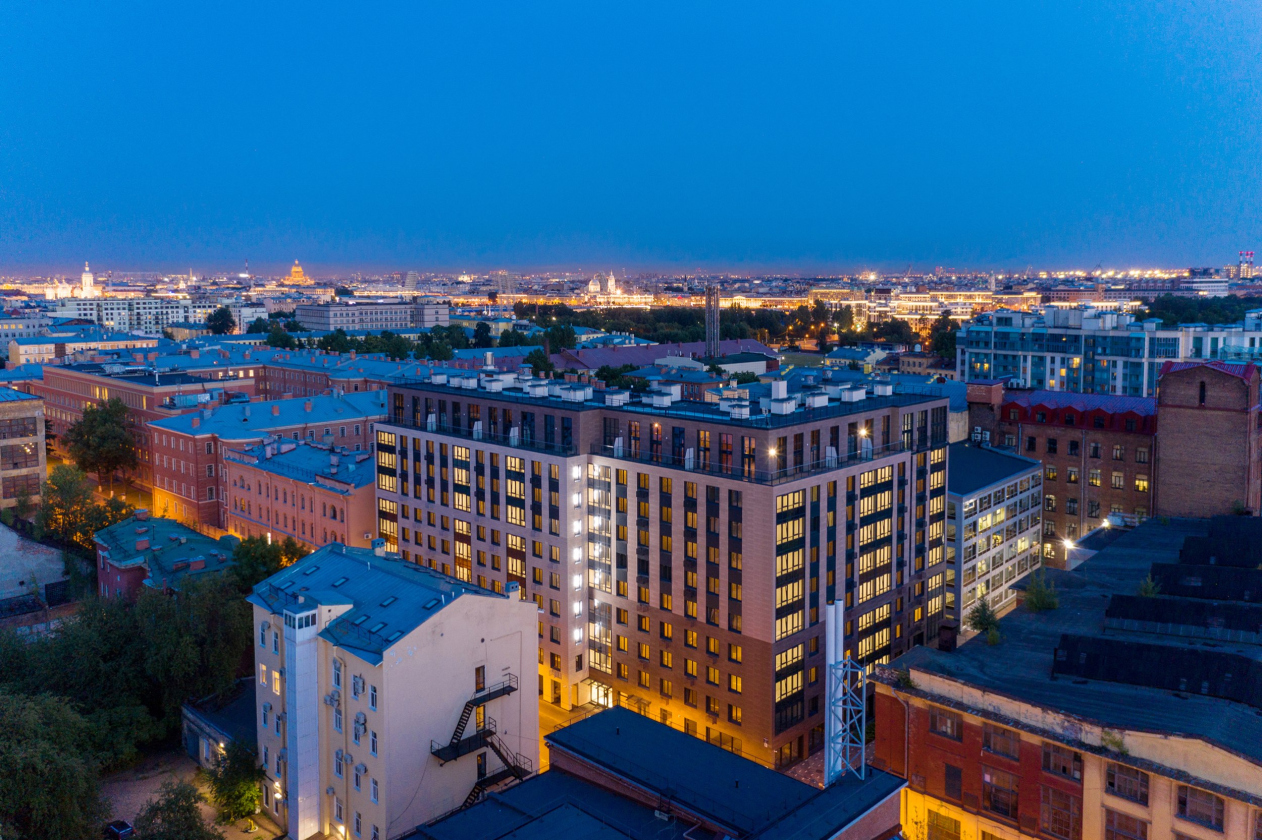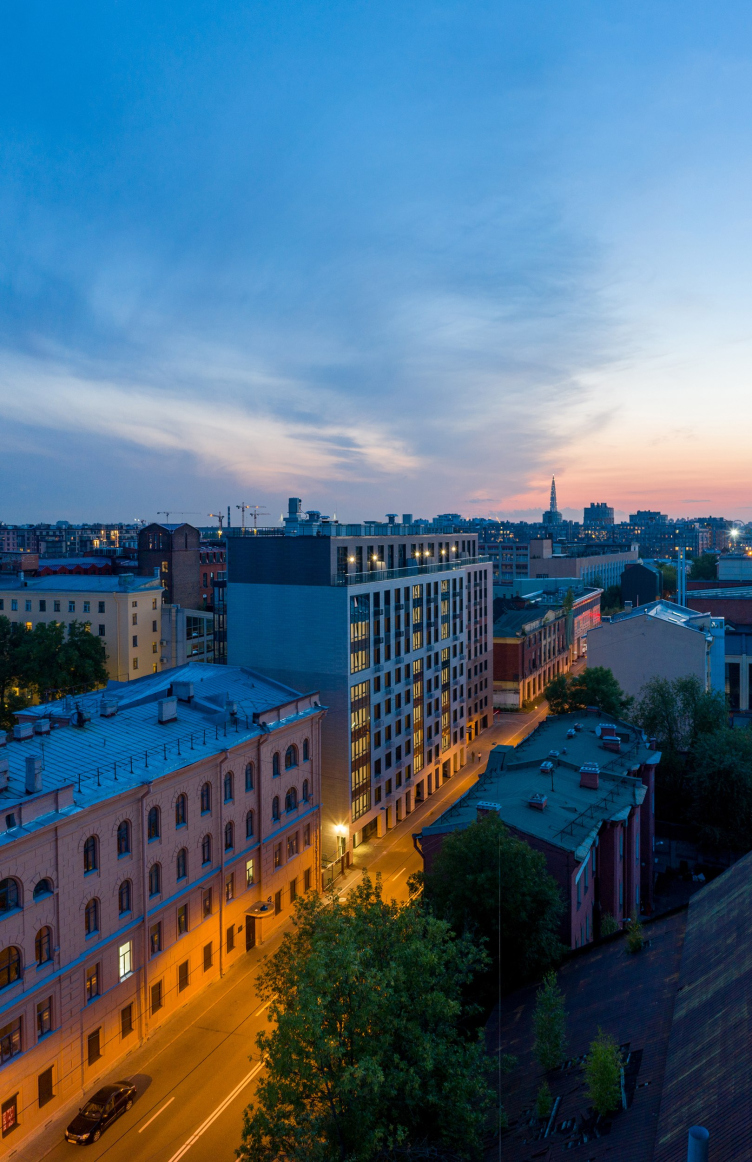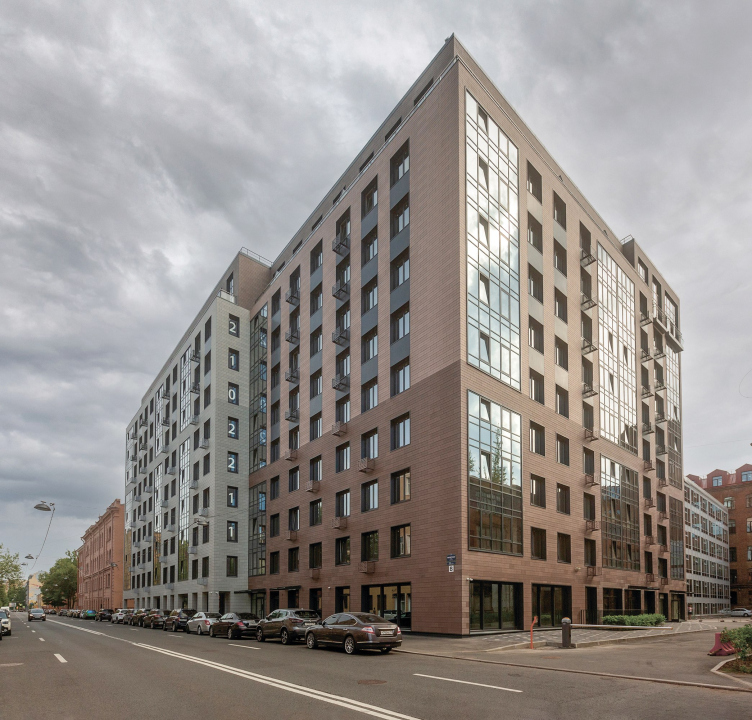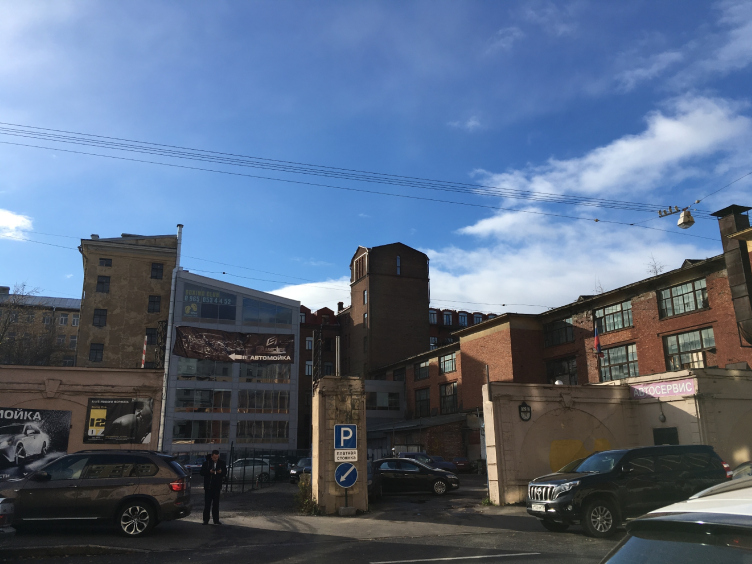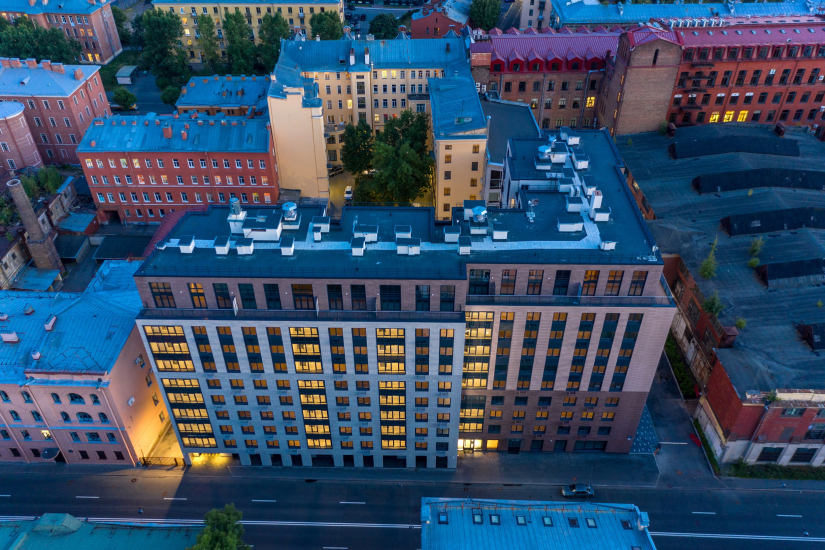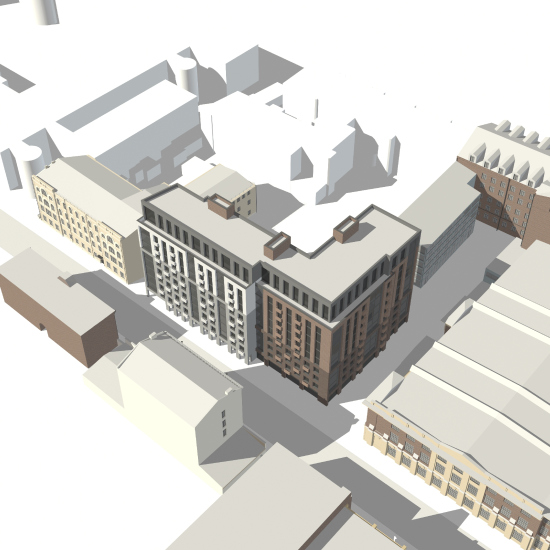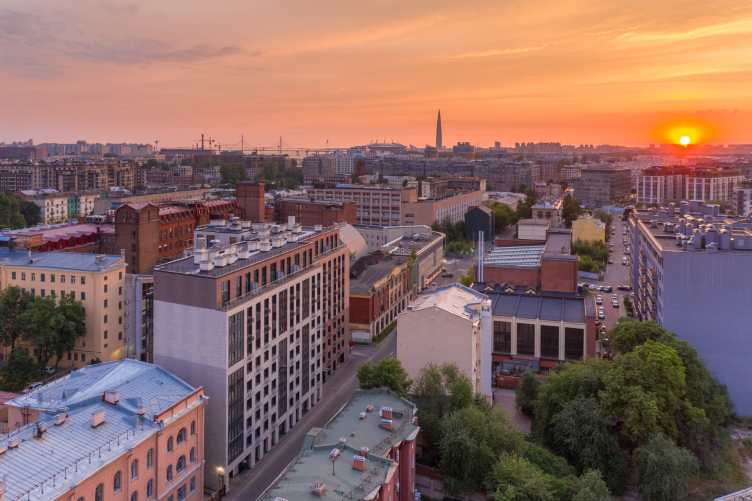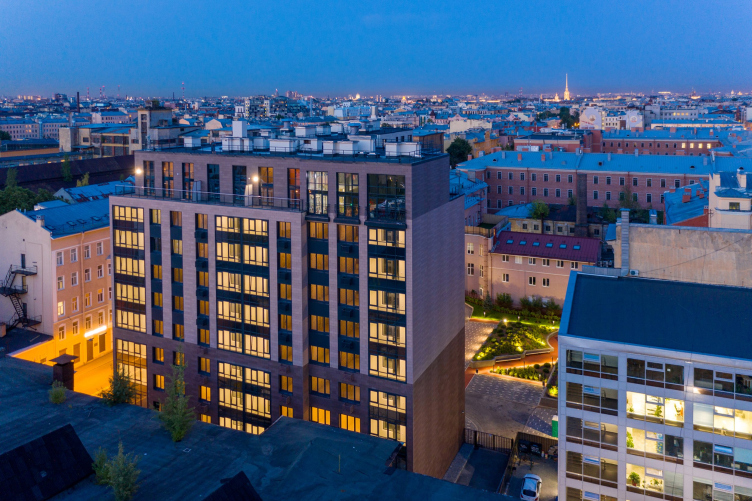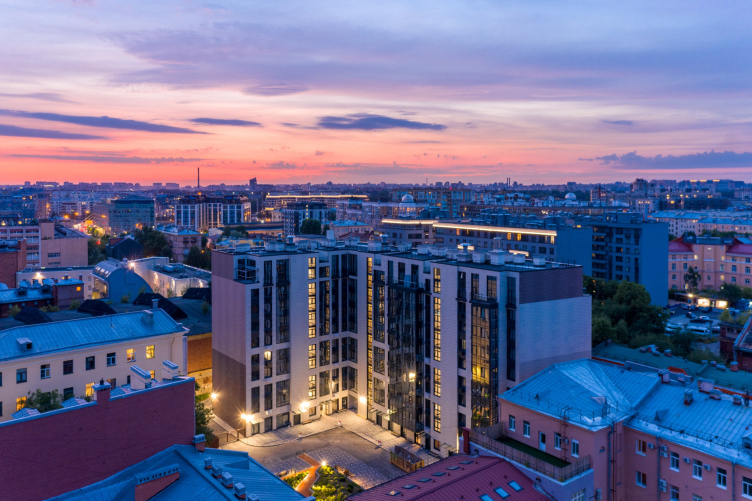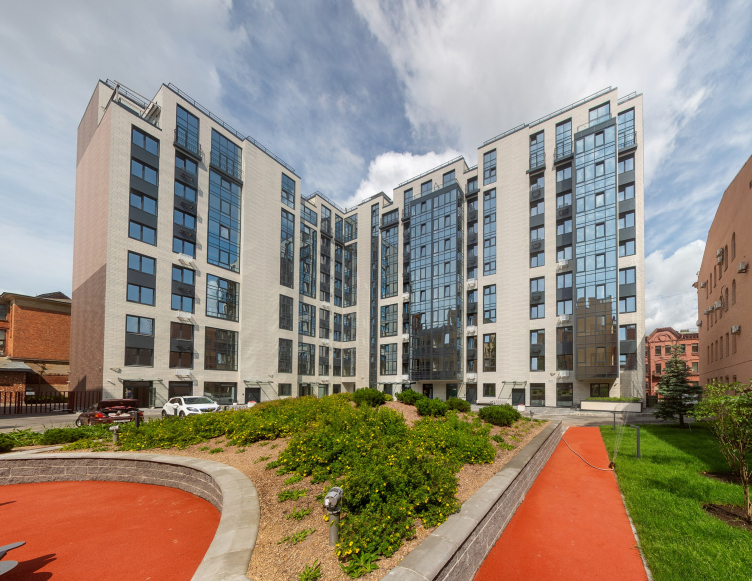The housing project on the Krasnogo Kursanta Street. Anatoliy Stolyarchuk architectural studio
Copyright: Photograph © Aleksei Aleksandronok / courtesy by Elba construction company
Some fragments of this area still do look a little bit sloppy – the crossing of the Pionerskaya and Korpusnaya streets, for example, has two empty corners; the space between the houses may unexpectedly “sag” to the height of a car dealership or a factory checkpoint, and in the early springtime the streets, clogged up with snow and cars, seem narrow and totally impossible to navigate. Nevertheless, the city spaces are gradually organized, and the “Kersten House” certainly played a part in this process: it absorbed the “codes” of the surrounding construction and formed the front of the street, not trying to “outperform” the substation building, which is the unquestionable centerpiece of this place.
The housing project on the Krasnogo Kursanta Street. Anatoliy Stolyarchuk architectural studio
Copyright: Photograph © Aleksei Aleksandronok / courtesy by Elba construction company
The house was built on a site that formerly belonged to the “Red Banner” factory. Before the 1917 “Great October Socialist Revolution”, it bore the name of its owner, Friedrich-Wilhelm Kersten, who bought a small workshop in 1866, and was able to turn it into Russia’s largest jersey factory. After it was nationalized in 1919, it was decided to use the sprawling factory as a basis for creating a model socialist enterprise, for the design of which Erich Mendelsohn was invited, who is known to have refused the authorship later on.
Over the century and a half of the century’s existence, some of its buildings were demolished, some remade into business centers and warehouses, some abandoned. The “Kersten House” grew up in the stead of a lacuna that was at the moment filled up with a car service, obstructing the picturesque and rather chaotic “insides” of the factory.
The land site on the Pionerskaya Street, on which the new house will be built © photo by Alena Kuznetsova
Copyright: © Photograph by Alena Kuznetsova
The actual house turned out to be very close to the original project; the differences are only in the materials that were used in the facade decoration: for example, the Klinker brick was replaced with terra-cotta ceramic panels, which is a pity because brick was more in line with the industrial spirit of the place. The volumetric design solutions, however, were fulfilled to a letter.
The house is composed of two volumes of different colors, one of which steps back a little from the redline of the Pionerskaya Street, and “swerves” into the depth of the site. The top floor, as is the custom nowadays with new construction in historical centers, recedes from the cornice, thus meeting the height restrictions and vacating the space for viewing terraces.
Thanks to the recessions, accentuated by the color of the cladding material, the house takes on a few layers, which can be interpreted as the first approach to parceling a large volume. This technique, by the way, became a signature one with the company: you can see it in the house on the Mira Street and in the newer housing complexes, such as Wellamo и iLona; the shift of the sections can be seen in the house on the Prilukskaya Street or in the hotel on the Veteranov Avenue. Curiously, even the building where Anatoly Stolyarchuk office is headquartered has layers in it.
The housing project on the Krasnogo Kursanta Street. Anatoliy Stolyarchuk architectural studio
Copyright: Photograph © Aleksei Aleksandronok / courtesy by Elba construction company
The next stage of mitigating the visual size of the new house is “proportioning” the facade grid. The rhythm is set by windows and recessed balconies grouped in the height of three or five floors, highlighted by graphite ceramic panels. In the bottom part of the building, the piers form something like a squatting grid; in the top part – something like verticals that look like pylons. A similar design technique is used on the facade, which swerves into the depth of the city block, at the same time working to enhance the perspective of the Pionerskaya street. The side ends of the building are essentially firewalls; in the yard, the horizontal molds get “blurred”, giving way to glazed verticals placed over a light underlay.
In the private yard, the architects found room for a playground with sports facilities, and even landscape compositions.
The housing project on the Krasnogo Kursanta Street. Anatoliy Stolyarchuk architectural studio
Copyright: Photograph © Aleksei Aleksandronok / courtesy by Elba construction company
The housing project on the Krasnogo Kursanta Street. Anatoliy Stolyarchuk architectural studio
Copyright: Photograph © Aleksei Aleksandronok / courtesy by Elba construction company
From the side of the Pionerskaya Street, there is a come-through grand entrance with a spacious hall, adorned by the pictures by the St. Petersburg artist Alexander Volkov, and a small set of historical photographs – you can even see them from the outside through the transparent doors. There is also a room for strollers, and a place where you can wash your dog’s paws.
The housing project on the Krasnogo Kursanta Street. Anatoliy Stolyarchuk architectural studio
Copyright: Photograph © Aleksei Aleksandronok / courtesy by Elba construction company
The “Kersten House” is relatively small – it has 132 apartments in it, their plans ranging from small studios to double-height apartments with terraces. The first floors on the Pionerskaya Street host various businesses; some of the premiers are situated behind the gallery, which gives the pedestrians some extra spatial impressions, as well as an opportunity for comfortable locomotion – the Petrograd Side is infamously known for its narrow sidewalks with room not enough for two. This particular location is already secured by a flower shop, a bar, and a beauty salon.
The housing project on the Krasnogo Kursanta Street. Anatoliy Stolyarchuk architectural studio
Copyright: Photograph © Aleksei Aleksandronok / courtesy by Elba construction company

